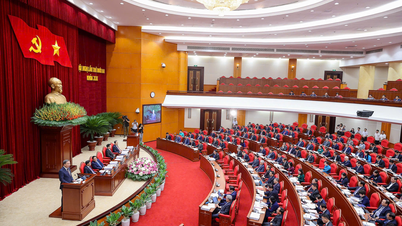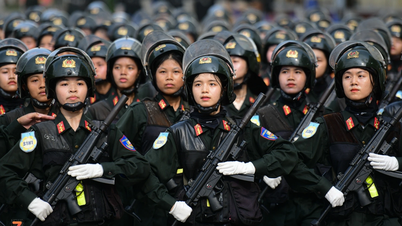(MPI) - The mid-term population and housing census at 0:00 on April 1, 2024 aims to collect information on population and housing as a basis for assessing the implementation of the Socio -Economic Development Plan for the 2021-2025 period; developing policies and planning for population and housing to serve the development of the Socio-Economic Development Plan for the 2026-2030 period; and monitoring the implementation of the United Nations Sustainable Development Goals to which the Government of Vietnam has committed.
 |
| Illustration photo. Source: MPI |
According to the results of the 2024 Mid-Term Population and Housing Census, Vietnam's population as of April 1, 2024 was 101,112,656 people. Vietnam is the third most populous country in Southeast Asia. After 5 years, from 2019 to present, Vietnam's population has increased by 4.9 million people. The average annual population growth rate in the 2019-2024 period is 0.99%/year, a decrease of 0.23 percentage points compared to the 2014-2019 period (1.22%/year).
Of the total population of the country, the male population is 50,346,030 people, accounting for 49.8%; the female population is 50,766,626 people, accounting for 50.2%; the urban population is 38,599,637 people, accounting for 38.2%; the rural population is 62,513,019 people, accounting for 61.8%. The average annual population growth rate of urban areas in the period of 2019-2024 is 3.06%/year, 1.5 times higher than the average annual population growth rate of urban areas in the whole country in the period of 2014-2019 (2.02%).
The whole country has 28,146,939 households, an increase of nearly 1.3 million households compared to 2019, an increase of 3.9 million households compared to 2014 and about 1.25 times higher than 15 years ago (2009).
Vietnam's population density is 305 people/km2, an increase of 15 people/km2 compared to 2019. Vietnam is the third most densely populated country in Southeast Asia, after Singapore (8,539 people/km2) and the Philippines (386 people/km2).
The Red River Delta and the Southeast are the two regions with the highest population density in the country, at 1,126 people/km2 and 814 people/km2, respectively. The Northern Midlands and Mountains and the Central Highlands are the two regions with the lowest population density, at 140 people/km2 and 114 people/km2, respectively.
The sex ratio of the population is 99.2 males/100 females. Of which, the sex ratio in urban areas is 96.7 males/100 females, and in rural areas is 100.7 males/100 females. The sex ratio varies by age group, being highest in the 0-10 age group (110.2 males/100 females) and lowest in the 80 age group and older (53.8 males/100 females). The sex ratio is almost balanced in the 40-49 age group (100.8 males/100 females) and begins to decrease below 100 in the 50-59 age group (97.3 males/100 females).
The Red River Delta is the most densely populated region in the country with 24.0 million people, accounting for 23.7% of the total population; the Central Highlands is the least populated region with 6.2 million people, accounting for 6.2% of the total population. In the period 2019-2024, the Southeast is the region with the highest average annual population growth rate in the country (1.46%/year); the Mekong River Delta has the lowest average annual population growth rate (0.29%/year).
The country has 19 provinces with small populations, under 1 million people; 37 provinces with populations from 1 to 2 million people; 7 provinces with populations over 2 million people. Hanoi and Ho Chi Minh City are the two cities with the largest populations, with 8,685,607 people and 9,521,886 people, respectively. The population difference between the most populous locality in the country (Ho Chi Minh City) and the least populous locality in the country ( Bac Kan ) is over 29 times (Bac Kan's population is 328,609 people).
Vietnam is still in the period of "golden population structure" with one dependent for every two people of working age. Of which, the proportion of the population aged 15-64 accounts for 67.4% (down 0.6 percentage points compared to 2019), the proportion of the population under 15 years old accounts for 23.3% (down 1.0 percentage points compared to 2019) and the proportion of the population aged 65 and over accounts for 9.3% (up 1.6 percentage points compared to 2019).
The aging index in 2024 is 60.2%, an increase of 11.4 percentage points compared to 2019 and 16.9 percentage points compared to 2014. The number of elderly people aged 60 and over is 14.2 million, an increase of 2.8 million people (equivalent to 1.25 times) compared to 2019 and an increase of 4.7 million people (equivalent to 1.5 times) compared to 2014. It is forecasted that by 2030, the number of people aged 60 and over will be approximately 18 million people, an increase of nearly 4 million people compared to 2024.
The proportion of the population aged 15 and over who has ever been married is 74.9%. The most common marital status of the population aged 15 and over in Vietnam is “Married” (65.3%). The average age at first marriage of the population is 27.3, an increase of 2.1 years compared to 2019, in which men get married 4.2 years later than women (29.4 years and 25.2 years, respectively). Women in urban areas get married significantly later than women in rural areas, the difference in average age at first marriage of urban women is 2.7 years higher than that of rural women (26.8 years compared to 24.1 years).
In recent years, generaleducation has seen significant improvements in terms of increasing the general and correct school attendance rates. The general school attendance rate for primary school is 98.7%, for lower secondary school is 95.6% and for upper secondary school is 79.9%. The correct school attendance rates for these levels are 98.3%, 95.2% and 79.4% respectively. With these results, it can be said that Vietnam has completed universal primary education and is approaching the goal of completing universal lower secondary education.
The general attendance rate at primary level has reached a high level and has remained almost unchanged over the years, while in 2024, the general attendance rate at secondary and high school levels will increase significantly compared to 2019 (secondary level increased by 2.8 percentage points; high school level increased by 7.6 percentage points).
The total number of people with high school degrees or higher nationwide accounts for 40% of the total population aged 15 and over, of which 41.2% are male and 38.8% are female. The proportion of the population with high school degrees or higher has increased significantly, up 3.5 percentage points compared to 2019 and up nearly 15 percentage points compared to 2014 (40.0% compared to 25.4%).
Nationwide, 73.6% of the population aged 15 and over do not have technical qualifications (CMKT). In other words, 26.4% of the population aged 15 and over in Vietnam has CMKT; nearly half of them have university degrees or higher (accounting for 11.6%). The proportion of the population with CMKT has increased significantly in recent years, up 7.2 percentage points compared to 2019 and up 9.2 percentage points compared to 2014.
The results of the 2024 Population and Housing Survey show that the average number of years of schooling of the Vietnamese population is 9.6 years, a slight increase compared to 2019 (9.0 years). Of which, the average number of years of schooling of men is 0.7 years higher than that of women; the average number of years of schooling in urban areas is 2.5 years higher than that in rural areas.
The expected years of schooling were 12.6 years, a slight increase from 2019 (12.2 years). There was virtually no difference in expected years of schooling between males and females, reflecting equal access to education across genders.
The total fertility rate (TFR) is 1.91 children per woman, below the replacement level. From 2009 to the end of 2022, for nearly 15 years, Vietnam's fertility rate remained relatively stable around the replacement level. However, in the last two years, 2023-2024, Vietnam's fertility rate began to show signs of decreasing more rapidly. In 2023, Vietnam's TFR was 1.96 children per woman and this number will continue to decrease to 1.91 children per woman in 2024.
The TFR in urban areas is 1.67 children/woman, lower than that in rural areas (2.08 children/woman). There are significant differences in fertility rates between socio-economic regions in the country. The Northern Midlands and Mountains, the Red River Delta, and the Central Highlands are regions with high fertility rates, higher than the replacement level (2.34 children/woman, 2.24 children/woman, respectively). Two regions with low fertility rates and lower than the replacement level are the Southeast and the Mekong Delta (1.48 children/woman, 1.62 children/woman, respectively).
Vietnam's crude birth rate (CBR) in 2024 is 13.5 live births/1000 people. This figure in urban areas is 12.8 live births/1000 people; in rural areas it is 13.9 live births/1000 people).
Vietnam's sex ratio at birth (SRB) is 111.4 boys/100 girls, much higher than the balanced level of about 106 boys/100 girls. This high SRB has been observed for many years in Vietnam. This is evidence of the long-standing sex imbalance at birth in Vietnam and warnings about the consequences of sex imbalance at birth, along with the drastic implementation of policies to eliminate intentional intervention in sex selection during pregnancy in Vietnam in the past have not been very effective; the sex imbalance at birth has not been overcome./.
Source: https://www.mpi.gov.vn/portal/Pages/2025-1-6/Ket-qua-dieu-tra-dan-so-va-nha-o-giua-ky-nam-2024nbhom0.aspx
























































































![[Infographic] In 2025, 47 products will achieve national OCOP](https://vphoto.vietnam.vn/thumb/402x226/vietnam/resource/IMAGE/2025/7/16/5d672398b0744db3ab920e05db8e5b7d)













Comment (0)